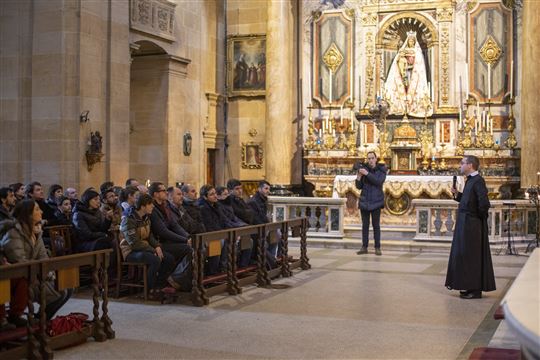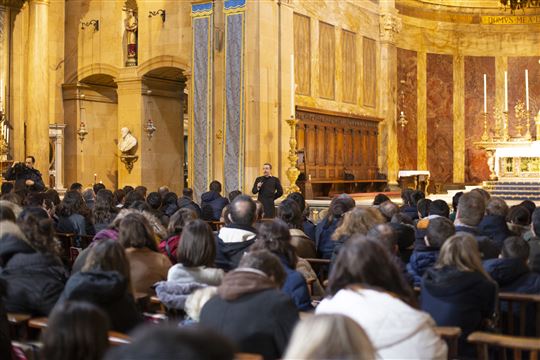
UK: Ex umbris et imaginibus in veritatem
In celebration of the canonization of St. John Henry Newman, the UK CL community organized a pilgrimage to the Birmingham Oratory, home to Newman for forty years. An opportunity to get to know better our first English Saint of the modern era.On 1 February, in celebration of the canonization of St. John Henry Newman, the UK CL community organized a pilgrimage to the Birmingham Oratory, home to Newman for forty years. There, on the anniversary of Newman’s establishment of the Oratory on 1 February 1848, we were welcomed by the Fathers and Brothers of St. Philip Neri. The Oratorians helped us to get to know better this new, first English Saint of the modern age, after more than 300 years.
St. John Henry Newman was received into the Catholic church by Fr. Dominic Barberi on 9 October, 1845. He then went to Rome for a brief period of training, where he met the fathers of the Oratory of St. Philip Neri. As Fr. Francis Gavin explained to us after Mass, what appealed to Newman about the Congregation of the Oratory of St. Philip Neri was the relative freedom it gave him. Oratorian clergy lived in small, stable, fraternal communities, leading that kind of communal life that Newman was already living with his Anglican friends. Moreover, as Fr Francis explained, “St. Philip Neri’s emphasis on a one to one relationship with the Lord and the role of the Holy Spirit appealed to the newly Catholic Newman”. Finally, since the Oratorians do not take vows of poverty, Newman could keep all the books he had collected over the years, allowing him to combine both intellectual and pastoral work. Newman thus decided to establish the first community of Oratorians in 1848 in England, in Birmingham. 
In Newman’s time, Birmingham would not have been perceived as a particularly obvious place to establish this new congregation. At the same time, Birmingham was a flourishing industrial centre, full of Irish immigrants, which “was helpful as he had an inbuilt congregation”.
The initial community set up by Newman in Birmingham was based in Maryvale, which then moved to Digbeth, a poorer area of the city where the community worked with the poor. Newman and the Oratorians were further charged, however, with converting the educated classes, as well as the poor, and so the community moved to the more affluent area of Edgbaston in 1852. The significance of the Oratory for Newman is evident from the fact that when made a cardinal, Newman petitioned to remain in Birmingham. This decision was fruitful: on 11 August 1890, upon Newman’s death, thousands of people lined the streets of Birmingham to pay their respects. These were not only parishioners and Catholics, but “people who, through the second half of his life, were impressed by his care of his adopted second city”, says Fr. Francis.
Newman’s presence in the Oratory, still today, remains very real and alive. Following his introduction, Fr. Francis took us into the main church to admire the art and architectural features of the church and allowing us the opportunity to pray at Newman’s shrine and venerate his relic. The current church was built following Newman’s death as a memorial to him. The small, original and architecturally modest church was transformed into a basilica-style church in a classical style, evocative of the Italian Baroque architecture Newman came into contact with during his period of novitiate in Rome. Newman deeply admired the classical style by virtue of its simplicity, elegance and purity, which he believed was suggestive of a profound yet imposing beauty. 
Attached to the church you find the chapel that is now the National Shrine dedicated to St. John Henry Newman. A modest casket in the chapel, decorated with the brass handles from Newman’s original coffin, preserves the few extant relics of the Saint, a lock of hair and a fragment of bone, the only remaining fragments from the Saint’s body. Following Newman’s beatification on 19 September 2010, Pope Benedict XVI became the first pilgrim to pray at the shrine, in what originally used to be the chapel of St. Philip Neri, where Newman himself prayed and offered Mass each day. There, together we prayed the prayer of thanksgiving for Newman’s canonisation: “Through his intercession we ask You to lead us always by the kindly light of the Holy Spirit, so that all mankind may rejoice to find Your truth, in the one fold of the Redeemer”.
Lunchtime offered an opportunity to visit the newly opened Museum of St. John Henry Cardinal Newman, set up and opened by the Oratory Fathers last October to celebrate his canonization. The museum includes a wealth of Newman’s possessions, such as manuscripts and liturgical objects and also a letter, dated 1845, where Newman declared his intention to “ask him [Dominic Barberi] to receive me into what I believe to be the One True Fold”.
In the afternoon, a further opportunity to get to know our new Saint better, through a talk on Newman based on the exhibition ‘The Certainty of Newman: Conscience and Reality’, which develops Benedict XVI’s reading of his life as a threefold journey of conversion. Beginning with a dialogue between Newman and the Modern Man, the path of Newman’s life is mapped, from which it emerges that conscience was the driving force of Newman’s journey: ex umbris et imaginibus in veritatem (‘out of shadows and images into truth’). The leitmotif of Newman’s journey of conversion can also be summarised through his own words, from the speech he gave when made a cardinal in 1879, “what is commonly a great surprise, when it is witnessed, is the particular mode by which, in the event, Providence rescues and saves His elect inheritance. Commonly the Church has nothing more to do than to go on in her own proper duties, in confidence and peace; to stand still and to see the salvation of God.”
Newman’s conversions were driven by obedience both to conscience and to the facts occurring in the circumstances of his life. Newman’s spiritual path allowed him to abandon himself completely to trust in God and to His infinite love. In doing so, in the words of Pope Benedict, “Newman was a person converting, a person being transformed, and thus he always remained and became ever more himself”. This pilgrimage offered the opportunity for us to ask that Newman’s knowledge and love of God pervade our lives, just as it transformed his. #JHNewman